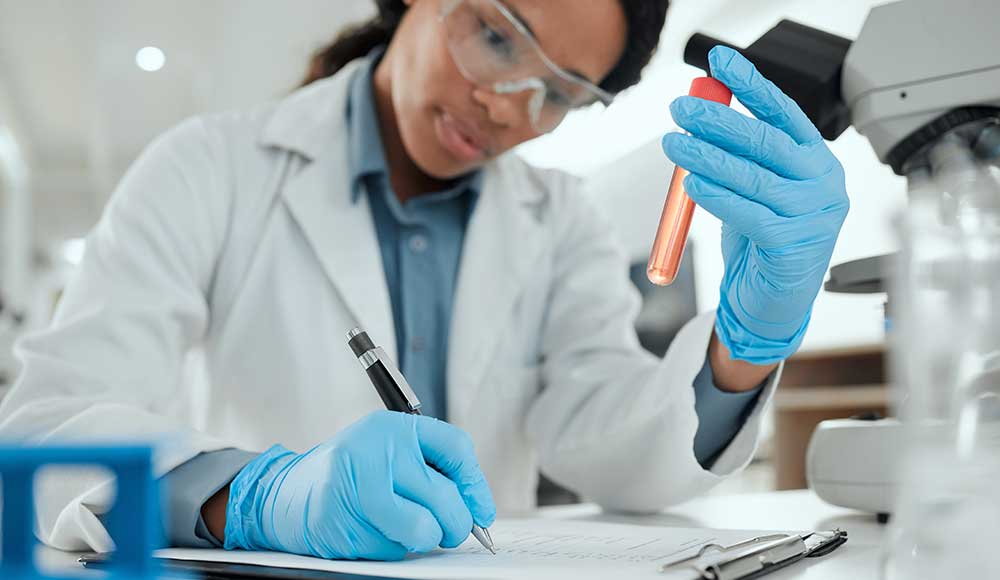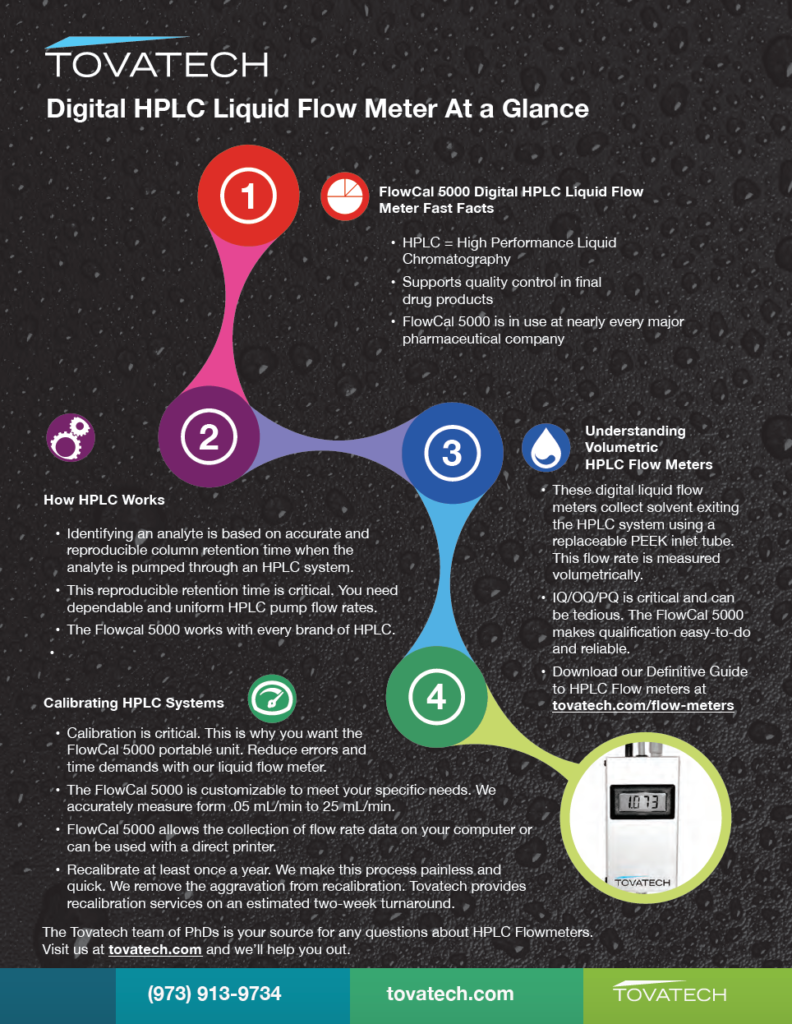
How to Check Pump System Accuracy for HPLC Analysis
Pump system accuracy is crucial for equipment used to conduct high performance liquid chromatography (HPLC) analysis in the pharmaceutical and other industries subject to regulatory oversight by the FDA and similar authorities. Among functions performed by HPLC are included checks for purity, monitoring changes in pharmaceutical intermediates during chemical synthesis scale-up, stability and dissolution tests, and performing ongoing quality control procedures.
A Brief on HPLC Analysis
Identifying an analyte by HPLC is based on accurate and reproducible column retention time as the analyte is pumped through an HPLC system. Reproducible retention time is critical and depends on accurate, uniform, reproducible HPLC pump flow rates.
Note that it is important to distinguish between accuracy and precision. These two terms may seem the same but they are not necessarily so. For example, an HPLC system (or for that matter many other systems such as analytical scales) may test out as precise. This means they always deliver the same results. But the results may not be accurate, meaning that they are precisely inaccurate.
So, how can problems occur? Well, a leak or other malfunction in the HPLC system will result in analysis errors. This means that HPLC systems should be regularly checked to ensure that the pump flow rate is properly calibrated. This is part of operational qualification. OQ starts before the HPLC system is put into use and continues as part of ongoing system calibration checks.
HPLC Troubleshooting
HPLC pump malfunctions are common causes of incorrect readings. The occurrence of pump malfunctions can be reduced with regular maintenance such as periodically replacing piston seals. Another important procedure is checking pump flow rate accuracy during routine performance verification of the HPLC system.
There are two ways to check pump flow rate accuracy. One is the manual way; the other is the easy way.
A manual check of HPLC pump flow rate accuracy is the volumetric method. It requires patience, sharp eyesight, a stop watch and a finely graduated cylinder.
The technician starts collecting HPLC eluent in the graduated cylinder and simultaneously starts the watch. When sufficient volume is collected the technician simultaneously stops the flow into the cylinder and stops the watch. The technician then calculates and records the flow rate in milliliters per minute.
Several measurements must be taken to calculate the standard deviation. This repetitive process accounts for the labor intensiveness of manual HPLC pump flow analysis.
The easy way to achieve flow rate measurement is using a liquid flow meter such as the FlowCal 5000 portable unit available from Tovatech.
How Digital Liquid Flowmeters Work
The compact, lightweight FlowCal 5000 digital liquid flowmeter operates by repeated and accurate measurement of the time it takes a solvent to fill a 140 microliter flow tube. As the solvent fills the tube the meniscus passes two optical sensors. These sensors are connected with an internal timer to monitor the transit time of the meniscus.
Otherwise stated, when the liquid enters the flowmeter at the bottom and begins to fill the measuring tube the meniscus passes the bottom sensor. This activates a timer. When the meniscus reaches the top it activates the second sensor that opens a valve and drains the tube.
Then the valve closes and the process repeats itself. New measurements update readings on the unit’s 4-digit liquid crystal display and data are transferred via an RS-232 interface to a thermal printer or computer for a 6-digit (xx.xxxx) reading.
The small volume of the sensing tube enables flow rates down to 50µL/min to be measured accurately and the measured flow rate is independent of liquid viscosity to 10 centipoise. Consistent readings indicate that the HPLC pump is operating correctly. A variance signals leaks or other malfunctions requiring attention.
Other FlowCal 5000 Features
Usable with any HPLC system the units are equipped with a single chip microcontroller and are supplied gravimetrically calibrated at 1.0 ml/min. Calibration at multiple points is available as the equipment has guaranteed linearity from 0.05 to 25ml/minute accurate to 1% of the reading. They are shipped with a mounting kit, a cleaning kit, and a UKAS (equivalent to NIST) traceable calibration certificate stating that the displayed flow rate is within ±1% of the actual flow rate at each calibration point. Everything including operating instructions is packed in a carrying case.
Calibration points recorded on the certificate result from an extensive process aimed at achieving statistically accurate data by taking, for example, 30+ readings at 0.5ml/min, 40+ readings at 1.0ml/min and ~100 readings at 5.0ml/min. Data are captured and averaged via an RS 232 interface to a PC. The certificate shows the average of these readings at each flow rate and calls that the displayed flow. In addition the certificate shows percent error and percent standard deviation.
Digital Flowmeter Recalibration Processes
In accordance with GLP (good laboratory practices) and to comply with other regulations, digital liquid flowmeters should be recalibrated annually or if it appears that the unit is not working correctly.
Certified test equipment is required to recalibrate the flow meters in order to issue a new calibration certificate. This is not an easy process and requires a constant flow rate water source. Adjustments, if needed, require access to firmware unavailable to users.
A more practical approach is returning the FlowCal 5000 flowmeter to Tovatech for recalibration, a process that takes about 14 days. The returned unit is accompanied by certificate of calibration as noted above and details the results of the procedure. Here is a brief description of the recalibration process:
The flow meter is first flushed with water. Then “as found” (or “before”) readings are taken at 1.0ml/min to measure the accuracy of the flow meter in the state in which it was received.
Customers may request that calibration certificates show the “before” data at all the calibration points rather than exclusively at 1.0 ml/min.
Then the flow tube is cleaned, sensors are checked, any repairs undertaken and necessary adjustments made to bring the flow meter into specification. The flow meter is then calibrated to all the customer’s required flow rates. The “after” data are recorded on the calibration certificate. This confirms that the returned flowmeter is performing according to specification.
How to Maintain Digital Liquid Flowmeters
Improper use can cause inaccurate measurements. Here are some tips to maintain the instrument.
- Do not introduce in immediate succession two immiscible liquids in the flow meter without either allowing the first liquid to evaporate or introducing a third solvent in which the other two are miscible.
- A poorly maintained sensing tube may trap bubbles in the tube and create high readings. If bubbles are observed turn off the unit and allow tube to drain for 2 seconds. Restart the flowmeter and allow it to refill.
- If the flowmeter is put into storage for a week or more it should be flushed with ethanol to prevent algae growth.
FlowCal 5000 meters in constant use should be cleaned every two weeks in an operation that normally takes about 15 minutes.
The supplied cleaning kit and instructions are used for this vital function. It does not entail disassembly of the sensing tube, a step that will invalidate factory calibration. Cleaning is a simple and straightforward process:
- Disconnect tubing connected to the inlet pipe at the bottom of the vertically mounted flow meter
- Power up the unit.
- Wrap a small tissue or clean cloth around the flow tube protruding from the top of the meter. This will prevent cleaning fluid from entering the flow meter via the nearby power and RS-232 sockets.
- Check the cleaning brush to be sure it is clean and is free of loose bristles or fiber
- Dip it into the cleaning fluid, insert it carefully into the flow tube and push it down until resistance is felt.
- Gently rotate the brush while moving it up and down in the tube, collecting any foam in the tissue.
After removing the brush, fill the supplied 20-ml syringe with clean warm water and connect the supplied blunt-ended Luer needle. Connect the small bore tubing to the blunt end needle then carefully push the tubing 20 mm into the top of the flow tube and slowly inject the warm water. Water will pass through the flow tube and out the overflow pipe at the bottom of the instrument. The FlowCal 5000 flow meter may report “Error 2” or “Error 4” and the valve may be heard to open and water drain through the drain outlet during operation. This is normal.
Refill the syringe with warm water and repeat this step.
The following step should be repeated two times to ensure all cleaning fluid has been flushed from the flow meter and that the sensor head has cooled to room temperature:
- Fill the syringe with clean cold water and connect it to the inlet pipe at the bottom of the flow meter.
- Place your finger over the top of the flow tube at the top of the flow meter.
- Slowly inject the cold water. Water will flow through the flow tube and out the overflow and drain outlet at the bottom. Error readings and valve open and closure may occur and likewise can be ignored.
- Clean up any spillage; re-connect the FlowCal 5000 flow meter to the pump and eluent, etc. Allow the eluent to flow for several minutes to flush out any water before taking readings.
FlowCal 5000 Field Experience
Advantages have been observed by users. An engineer at a pharmaceutical industry service supplier stated that he was familiar with the gravimetric method and all of its challenges. He said a FlowCal 5000 flow analysis can be completed in less than 5 minutes including the all important data output for record keeping. This, he said, represented a 15 to 20 minute savings in time over the gravimetric method.
A metrology technician at a pharmaceutical company commented that a main advantage of the FlowCal 5000 is that there is no need to monitor flow rates using the time consuming graduated-cylinder-and-stop-watch method. Other benefits include ease of use, highly accurate readings and saving time.
For more information on operating and maintaining FlowCal 5000 digital liquid flowmeters contact our scientists for answer to your questions on this valuable laboratory equipment.

